
|
Note ye ed's email address: stevebryant99@gmail.com. |

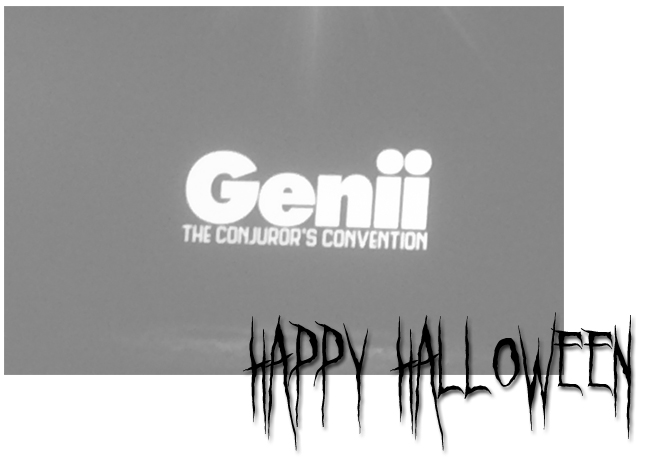
|
Last month's September issue discussed Michael Carbonero at Indiana University, a John Guastaferro download, and favorite guests on "Penn and Teller: Fool Us." And our Halloween 2016 issue featured the publication of McGrave's Hotel and "my" Sixty Year Celebration of It's Magic!, a farewell to MAGIC magazine, and a review of Talisman. |
October 2017 Happy Halloween, and welcome to another black and white edition of Little Egypt Magic. Turn out the lights and settle in with this year's tricks and treats: my incomplete review of the Genii convention, the new Harry Lorayne book, a three-part seance to conduct in your home, and a farewell to the amazing Philip Morris. My sister-in-law, who teaches calculus, also delves in crafts, hence the spooky collage pictured at the bottom. It's a lovely collection of 3D cutouts, feathers, and knickknacks. Thanks, C.H. |
|
|
SHORTCHANGED --For good reason, the planet is unhappy with us, hence an excess of earth, fire, flood, and wind. From Houston to Florida and Puerto Rico, especially, the hurricanes have sucked. To avoid driving through the swath of Hurricane Nate, Maleficent and I departed the recent Genii convention a day early, thereby missing the last day: the close-up show, lectures by Jim Steinmeyer and David Ben, one-man shows by Peter Samelson, Jean Merlin, and "Dai Vernon," and a gala that closed with Guy Hollingworth's new manipulation act. Damn.  The Genii is back in the house. My disappointment in missing the final day was intensified by how much I enjoyed the first three. Stuff that made this my favorite 3/4 convention of the year follows: LECTURES. Highlights from the Steve Valentine lecture included multiple ending ideas for the Card Stab in Paper Bag and an endless silk production from a metal steampunk gizmo called a Wonder Box. It was like Hartz's Devil of a Hat routine applied to a silk production. John Bannon (with noted Marlophile Jimmy Nuzzo as one of his volunteers) taught such personal favs as Proxy Shock, Origami Poker, and Stealth Aces. Curtis Kam explored endings in magic routines (and had a really funny bit with a thimble routine). Mike Caveney recounted his purchase and curatorship of his Egyptian Hall museum. When he and George Daily were asked to bid on the entire contents, Mike complained that they hadn't even seen a room full of file cabinets. The owner's response: "You'll like the file cabinets." Jim Steinmeyer taught tricks that too many of us had overlooked in Genii. Pit Hartling, very funny as "best German close-up magician in his weight class," taught an impossible location based on Jordan's study of chains in card shuffles. Jean Merlin showed us fascinating new material with ropes, and Bernard Bilis, also of France, some of his excellent card tricks. Michael Weber conducted a late-night lecture on marked cards (deck included) that I missed, but I did catch his $100 extra-pay event (numerous props included). He impressed me with: A dollar that morphs to a hundred in your fingers, a la a roller printer. A Tenyo-like zig-zag prop with ear buds. A math-based skit with three couples in which the "random" rearrangement allows each to turn around and kiss the person behind them. A trick with a box of candy left about, like an impromptu trick from The Jerx. A nifty ten-card poker routine (too new for Ten). The sock trick from Life Savers. A version of OOTW in which the dealt cards never cross an invisible line. And a memory stunt in which a six-digit number on the back of an envelope encodes its contents. (Note: you can do this without a memorized deck if you use Lewis Jones's Memory Deck, from Seventh Heaven.) All fun stuff. INTERVIEWS. There were two, and each was special. A star-struck Richard Kaufman (he had caught the touring show in Louisville) interviewed David Blaine for 90 minutes. Richard likened David's appeal to that of Houdini, and it was fun to hear David reveal the thinking behind it. Part of David's motivation toward genuine physical stunts was that traditional magic tricks can be explained on YouTube. Fun facts: David gets along with the frogs that he swallows, and he used the same two frogs throughout the 40-city tour. And he is cutting back on life-threatening tricks as he now has a daughter to consider. David closed the interview with a performance piece, beginning by having his lips sewn shut. Three seats away from me, Jade was moaning, "Oh, my god." Eventually a selected card is found folded inside his mouth. This ups the ante on the question of why lose a card only to find it (or sew your lips shut only to cut them open). 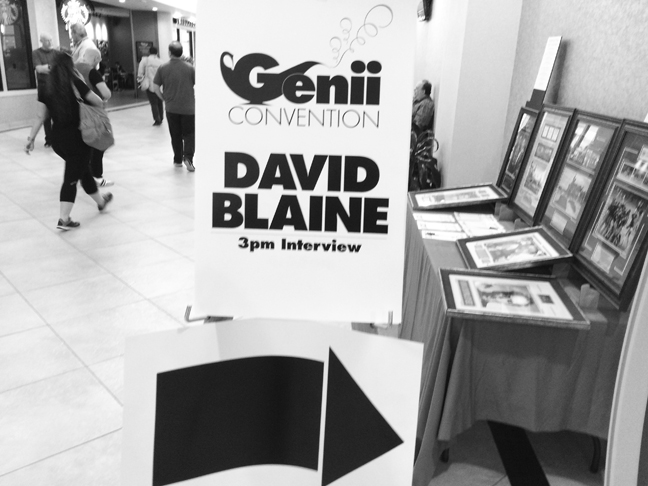 The interviews were inspiring. The second was a 60-minute interview with Paul Harris by Michael Weber. Paul is one of the true originals in magic, and he touched on his influence from Harry Eng, his vagabond life style (I couldn't help thinking that Eugene Burger chose a similarly spartan, focussed style, though he never lived in a tepee), and the recent idea of performing one miracle. It particularly impressed me that numerous famous magicians brought books for him to sign and wanted to pose for photos with him. My own feelings toward Paul reach way back, to when he was young and I was sort of young, in San Diego, when we both received life tips from the wonderful Mary Martinez. For the record, my three favorite Paul Harris effects are Nightshades (the original mechanical version), Las Vegas Leaper (the risque version), and Deep Astonishment (Paul's four-letter word prediction that has made people think I am in league with the devil). 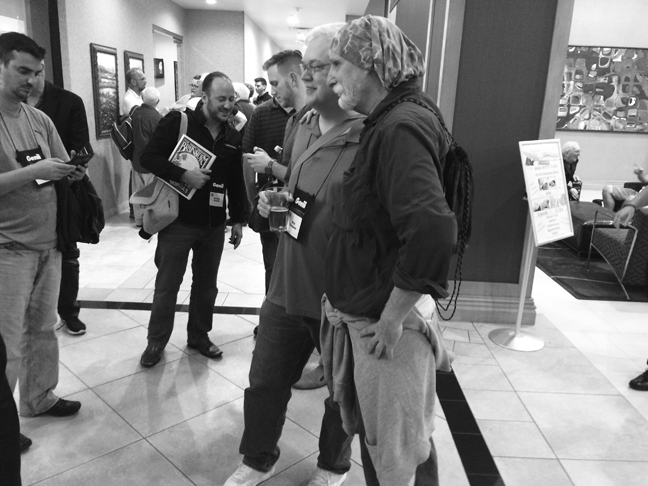 Not-so-retired genius. TWO-MAN (AND MORE) SHOWS -- Tag team magic is a kick and was especially so with France's Jean-Jacques Sanvert and Bernard Bilis. The two performed highly original card magic, first individually and then together. The closer was a Malini-like card stab routine in which JJ stabbed a knife through Bernard's hand, Bernard then sawed his own hand off with a buzz saw, and the severed hand was then lifted to show the selected card impaled on the other side. Giving youth its due, Robert Ramirez and Naathan Phan performed a series of comedy magic vignettes titled Variations on a Theme, my notes highlighting a routine in which the boys simultaneously swallowed a long balloon a la the spaghetti scene in Lady and the Tramp, as someone nearby said, "Wrong on so many levels." Although I caught only one of the two gala shows, I certainly enjoyed the one I did, with Guy Hollingworth as emcee and performing his Reformation and Twisting the Aces. Guy handed us Brett Loudermilk with crowd cringing sword swallowing (plus phallic gags), John Carney in a memorable acting and magic turn as L'Homme Masque, and Shintaro Fujiyama with traditional Japanese stage magic and a crowd pleasing Ten Ichi thumb tie. The evening closed with John Gaughan presenting his chess-playing automaton The Turk, over 250 years old. The Turk played an endgame against Gene Matsuura to a quick checkmate. Spooky! I have no idea. ONE-MAN SHOWS -- If I had to name the three items that made this convention one of the top gatherings ever, it would be the two interviews plus Max Maven: Thinking in Person. Max made a triumphant return from his absence two years earlier, and he had me from the get go, with the erudite dissection of his four opening words, "Once upon a time." Thinking in Person is a two-hour show with a 15-minute intermission (during which the performer revamps his hair style). There is some mentalism along the way, things with cards and chairs and keys and the mystery of whether a dime under a cup is face up or down, but the memorable bits are the grand sweeps of language and the frequent pedantic chiding, the knowing sidelong glances. It's nice that the audience is invited to think along with him. 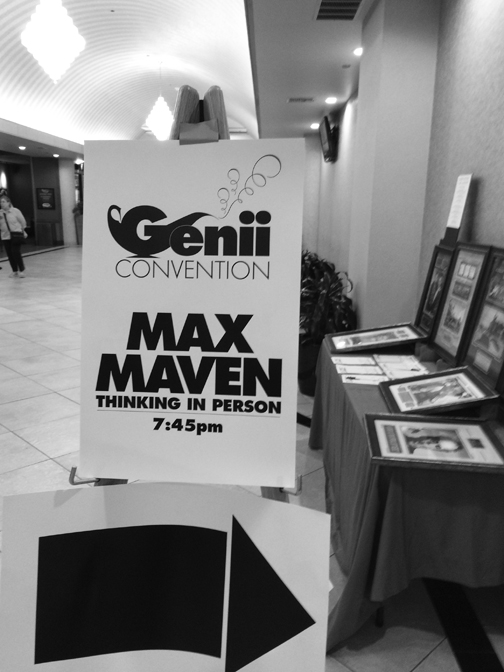 Two years in the making and worth the wait. Yes, Harrison Greenbaum does some magic, including getting far more than most out of Mental Epic and Paul Harris's Whack Your Pack, but it's his insanely irreverent humor that makes you glad to be alive. (I say this even though he left out my favorite Harrison Greenbaum joke.) Harrison excels at toying with the audience, and he couldn't have asked for more perfect subjects than a Catholic priest and a kid named Chance. It was a take no prisoners performance building to a grand meltdown rant that demanded a standing O. AND SO MUCH MORE. Sound and video were excellent, and most shows and lectures played on and off to to the live music of Mike Close on the keyboard. Bravo. Genii swag is always interesting, and so it was. A canvas and leather satchel seemed the most popular item, accompanied by a Genii mug and saucer, a box of snacks, a drink sleeve, five DVDs*, a Lies deck from Murphy's, and a nice marked deck from Penguin. 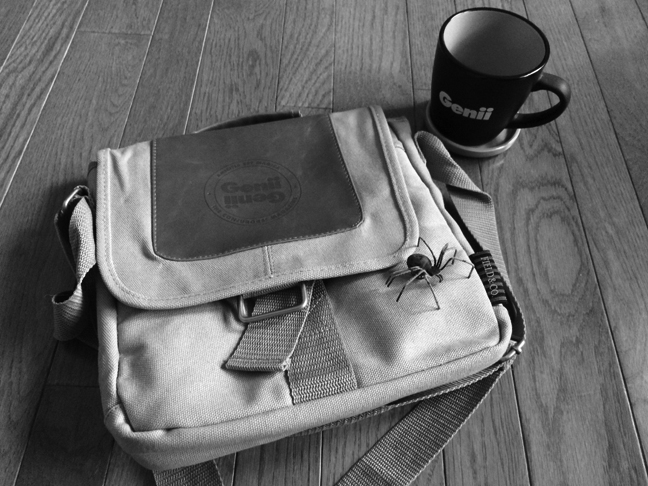 Favorite bits of Genii swag. If there is a complaint that I have about Genii conventions, it is that there is too much to love. My exact words from two years ago still apply: "If I have criticism of the Genii convention, it is that it was too packed with don't-miss lecturers and performers. There was too little time between events to socialize or even visit the dealers." I hadn't meant to leave a day early, but even so regret not even speaking to such friends as Tony Miller and Andy Greget. Nevertheless, I caught some of the stuff going on outside the printed schedule. Asi Wind drew crowds on at least two late-night occasions. And my favorite impromptu moment was Thursday morning, when Tom Gagnon and David Ben were trading passes, shuffles, and history. Ed Marlo and Ross Bertram credits popped up frequently. This session constituted, easily, the best magic of the convention. 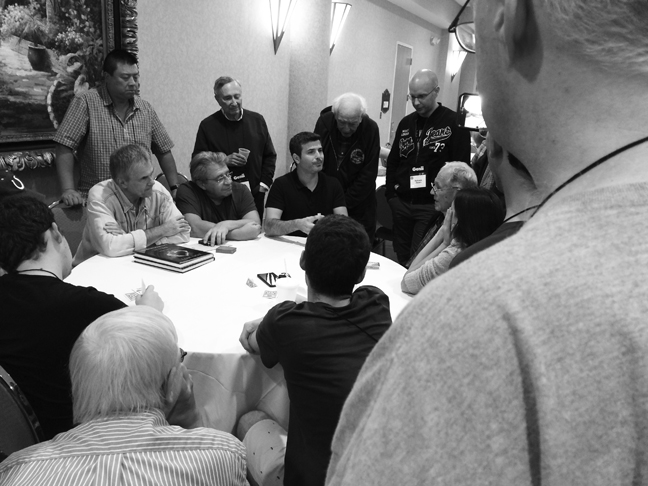 Asi attracts a distinguished crowd. 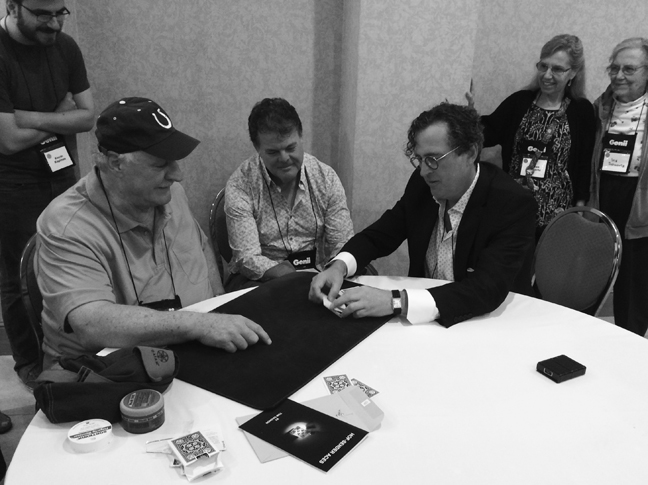 Trading passes, shuffles, and history. Thanks to Richard and his talented team for putting this on, to old friends who make my day every convention, and to new friends who said hi and commented on this sheet or on my books. *I watched one of the five DVDs, The New York Magic Symposium 1986. Where were you in '86? Hard to believe our top magi looked so young, thin, and hirsute. Are today's kids as good as these pros? I don't think so. |
|
|
SON OF JAW DROPPERS! -- Surely this is a first: a book of new card magic with an eight-page spread of photos covering the author's 90th birthday party. Even more astonishing, Jaw Droppers! Two is a young man's book, marked by energy and enthusiasm, fueled by the idiosyncratic conversational prose and card magic of Harry Lorayne. (We all grow old. Harry's books stay young.) Harry began this book from pages of handwritten notes on the Best of Friends series, but the scope widened as he brought simpler methods to bear, a nod to age and arthritis. As time diminishes my own abilities, these are welcome modifications, and as Harry notes often lead to completely new routines. 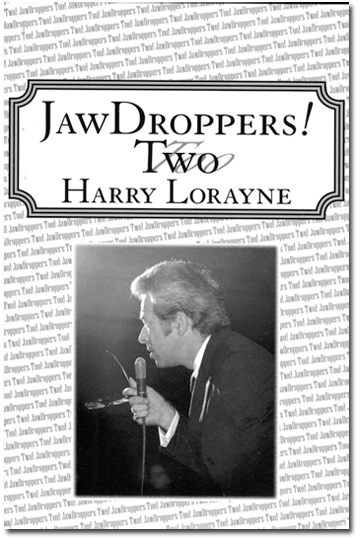 Vintage Lorayne. The contents are generous, nearly 80 titled items divvied among seven sections (a breakdown that has mystified me all the way back to Close-Up Card Magic). Although many rely on familiar methods (the HaLo Cut, Universal Reversal, the Lorayne Force, Illogical Double Lift, and so on), I favored the more oddball solutions, as evidenced here by five favorites: Voice Print. Uses only A-4 of two suits. You gauge the spek's voice for Truth then perform an impressive Lie Detector test. Lost and Found. I've always loved the Allerton-Christ routine where you form four piles counting backward from ten. In this version the spek tells you when to stop for each pile, yet the cards locate a selection or prediction. Gr(Eight). A very direct math (a la clock) trick. You spell to the eight of clubs and always locate the selection. My favorite trick in the book. Off-the-Rack 3-Piece Suit. A takeoff on a Max Maven version of the Hofzinser Aces. Easy! S/H/F/ Killer. A stunning transposition based on miscalling three cards. Perhaps the most clever item in the book. And much more. AMAZING Plus is an organic aces to royal flush routine that plays well. Triumphant Cut-a-Way extends Daryl's Triumph cutting sequence. Weird Spread Palm gets you right into Tamariz's TPC. An Impossible Location contains a shuffle that keeps reds and blacks separated. Twisted Appearance is a Twisting the Aces with the bonus of finding a selection. To the Point is a fast ace assembly. Discrepancy Sandwich is a new sandwich strategy. And so on ... 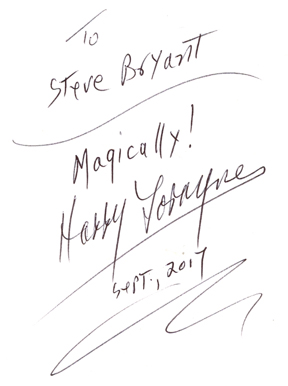 Thank you, Harry, for all the great card tricks. It's hard to read this book without considerable emotion, and you have to love the voice. Harry Lorayne card magic has been part of my life for over 50 years. The photos of the birthday party are courtesy of Steve Cohen and Alan Frankel, and they pop. It's heartwarming to see so many friends and idols among the gathering. The classy book design and composition are by Andrew Pinard, the routines are illustrated by numerous Matthew Potter photos, and the book is decorated by various awards and commendations bestowed on Harry. Hardback with dust cover, 252 pages, $84.90 with postage by check, direct from Harry Lorayne, 48 Liberty Street, Newburyport, MA 01950. |
|
|
A SEANCE TRILOGY -- It has been a while since I performed a Halloween show such as described in The Little Egypt Book of Ghosts. Often, it is a new spooky magic trick, a book such as Eugene Burger's Spirit Theater, or some unique Halloween prop that kindles my desire to "put on a show." This year, it's a delightful prop, an antique haunted movie projector. I first obtained mine through grandinroad.com, but they sold out in early September. I have also seen it elsewhere on line and in one of the Halloween super stores that open seasonally in empty K-Marts. (Note: it is not the projector sold at Target.) As pictured below, the projector is about 8 by 11 inches in profile. When you turn it on, its reels turn, and it plays Scott Joplin's "The Entertainer," rather loudly, as it projects a movie of a dancing skeleton on the wall. It runs for an eerie 45 seconds, and the whole thing struck me as ideal for a Halloween party. Because of the projected light, I decided I could use it as a spotlight, for such visual magic as card fan productons. As I can't do card fan productions, I decided on something else, hence the three-trick Seance for a Home Dinner Party that follows. Atmosphere: Music from Midnight Syndicate plays softly from another room. (This was a tip from Leo Kostka.) The light at the dinner table is very dim. I place a candelabra with three battery-powered candles in the center of the table to begin the experience. Possessed: This is the routine for Magic, Inc.'s Matchless Matchboxes (still available from Magic, inc. for only $9.95) as written up in The Little Egypt Book of Ghosts. The routine ... 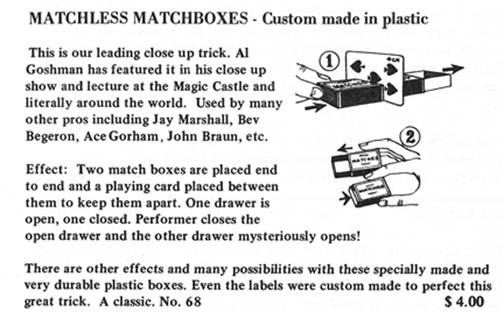 Still a bargain. Introduce the matchboxes. They are adjacent, “back to back,” with both drawers fully closed. The mechanics here, as best I recall, are those provided with the original instructions. "When I was lighting these candles earlier, I ran into a strange problem. First, no matches … but that wasn’t the problem. The candles are electric.” Push both drawers all the way out, so that they land on the table. Next place the sleeves onto the table, butted together end to end. “It was this. When I placed one drawer in … everything seemed normal.” Insert one of the drawers and push it all the way in. “But when I placed the other in, it was as though there were a physical mass between them. One goes in, the other goes out.” Demonstrate this phenomenon. “I took this seven of diamonds and placed it between them … but it didn’t stop! It began to shape up as a Class 3 paranormal manifestation.” Place the playing card between the two sleeves to form a barrier, as shown in the ad. Continue to demonstrate how one drawer seems to force the other out. “It got weirder when I turned the boxes 90 degrees. One drawer seemed to actually repel the other.” Leave the card in place and turn the boxes 90 degrees to each other. One drawer will still push the other out. “I separated the boxes completely … but it didn’t help.” Toss the playing card aside and hold the boxes between your thumb, index, and second fingers, as if you were holding multiplying candles. Your index finger hides the line between the two boxes. (The boxes are held vertically, your fingers pointed toward the ceiling.) “Put your finger here …” Have the spectator place his index finger on the protruding drawer. “Press down slowly. Isn’t that creepy?” When the spectator presses down on one drawer, the other rises in exact sympathy. Continue to demonstrate the sympathy by alternately pushing on each drawer yourself. “It was later that I realized the matchboxes had a history of psychic turbulence … allegedly involved in an arson … and I knew there could be only one cure, the same antidote for vampires—garlic!” Blow on the matchboxes, turn the sleeves back to back, and push both drawers closed simultaneously. “Ah, that Caesar salad …” And put the boxes away. From Beyond the Veil: This is my favorite impromptu spooky card trick, from Peter Duffie. The complete routine appears in The Little Egypt Book of Ghosts. The routine first appeared here in The Little Egypt Gazette, the September 1997 "British Edition," featuring tricks from Peter Duffie and Simon Lovell, and it is still there. If you choose to look it up (see "Tutorial"), you may be asked for a user id and a password to access the secret material. If so, read the text that follows the link. It will tell you what to use. (Warning: it's one of my harder clues, but nowadays you have google.)  Did my crystal come from Czechoslovakia or Japan? Actually, any strong card revelation will do [such as Gr(Eight) from the new Harry Lorayne book], as I wanted for nostalgia's sake to use a crystal ball that I purchased from Nelson Enterprises back in junior high school. It's smaller in diameter than crystal balls I purchased later, but much clearer. I enjoy using it. Movie Night: Ah, now for that haunted projector. As suggested, I wanted to do something visual, so decided on a spirit slate routine. "Back in the silent movie days … mediums attempted to contact ghosts through spirit writing on children’s school slates." Number the surfaces 1, 2, 3, 4. (I make small numbers in the upper left corner, not full-size numbers as in the photos from Eugene Burger’s Spirit Theater.) "I thought perhaps, with the help of an antique movie projector … we could turn back the clock to that time … and demonstrate what that looked like." 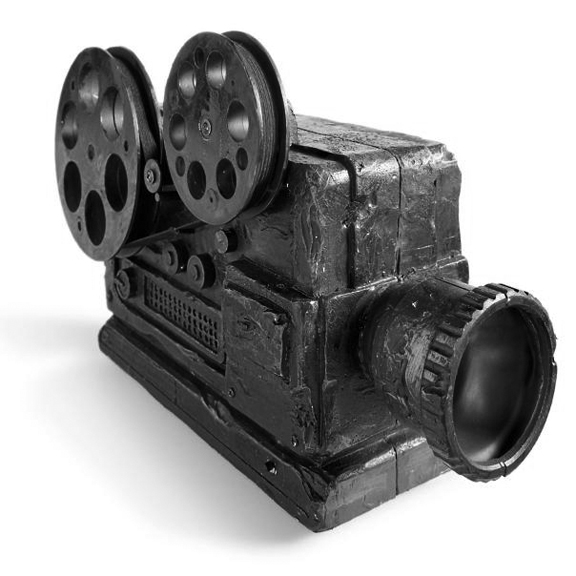 Haunted antique movie projector. Introduce the projector and turn it on. After a few seconds of a dancing skeleton, use the projected light as a spotlight. Show both sides of the slates, sandwich them, flip them over: "If we summon the spirits …" Gesture (I wave a piece of chalk over the slates), then separate the slates to reveal the first message: KNOCK
KNOCK (Note: this wording comes from from John Lovick’s “Little House on the Scary” slate routine, in The Performance Pieces & Divertissements of the Famous Handsome Jack etc.) "You can say it with me: WHO’S THERE?" Audience says, “Who’s there?” Medium peeks at message and says: "Nooooooo body." Turn over second slate to reveal its message: NO
BODY (Note: I’m not sure why I thought of this gag. Perhaps from a Disney cartoon. Or from the hero of Neil Gaiman’s The Graveyard Book, Nobody Owens.) Ta da. I hope I have posted this edition in time for you to acquire one of these projectors. Sometimes really cool props appear for one season only. It's wise, when this happens, to buy fast and to buy a spare. Ask any of my friends who have been searching for just the right rubber snake.
DR. EVIL, I PRESUME -- The sad news continues: spook show legend Philip Morris passed away September 25th. Born Philip Morris Daniel Smith in Kalamazoo, Michigan, Philip Morris encountered magic at Abbott's by age six. I shared a birthdate with Mr. Morris: January 8. More precisely, Morris shared the exact birthdate of Elvis Presley: January 8, 1935. According to Walter Hudson, writing in Abbott's spooky web site Creepy Magic, Morris began as a magician touring Michigan in the early 1950s. By 1953, he transitioned to the South, hooking up with the appearances of cowboy film star Lash LaRue. Working with LaRue introduced him to the agents and theater owners he would revisit with his famous spook show. (A personal note: As a boy, I was a big fan of Lash LaRue and Whip Wilson, and I owned a bullwhip. Although Lash never came to our hometown, we did one day welcome the Cisco Kid.) 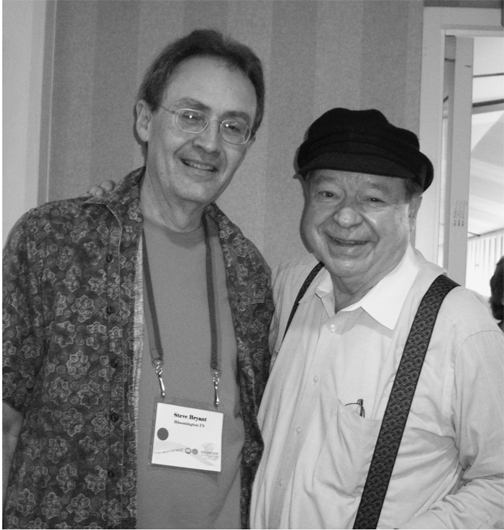 Getting to meet a legend. Although most of the midnight ghost shows folded by 1959, the Philip Morris show, starring Morris as Dr. Evil, continued into the 1970s. Morris toured Canada in 1973 and, citing Mark Walker's Ghostmasters, gave his last perfromance in Huntington, West Virginia, on New Year's Eve, 1977. Over the years he was a magician, a ghost show operator, a ventriloquist, both a TV kid show performer and a late-night TV horror movie host, and, most recently and successfully, the nation's largest supplier of Halloween costumes. I was thrilled to meet him at the IBM/SAM combined convention in Louisville, 2008.
|
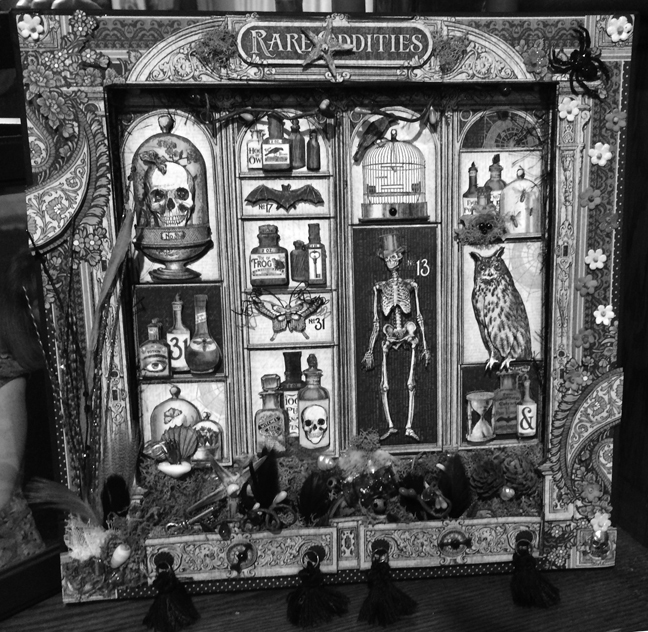 My sister-in-law is crafty.
Aloha, Hugh Hefner.
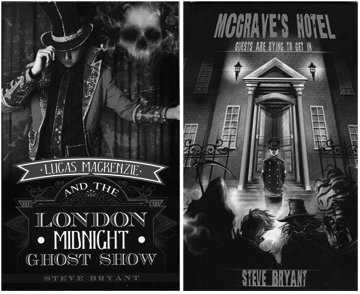
Halloween is coming! I dare you to read McGrave's Hotel and Lucas Mackenzie and The London Midnight Ghost Show.
Little Egypt Magic is the erratically updated web site of Steve Bryant, spawned (the site, not Steve) by a former internet magazine known as The Little Egypt Gazette/for magicians only. Steve Bryant is an obscure magician and writer who generates this site from an iMac in Bloomington, Indiana. He used to frequently journey to and perform magic in Little Egypt, the local name for extreme southern Illinois, where the towns bear such names as Cairo, Thebes, and Karnak. Past issues of this web site: Index to Past Issues Notice: Any limited use of copyrighted images or quoted text is considered fair use, usually to review whatever product or event that is under discussion. If you object to use of any material, please get in touch and it will be cheerfully removed. |
A JSB Creations product
Copyright© 2017 by Steve Bryant